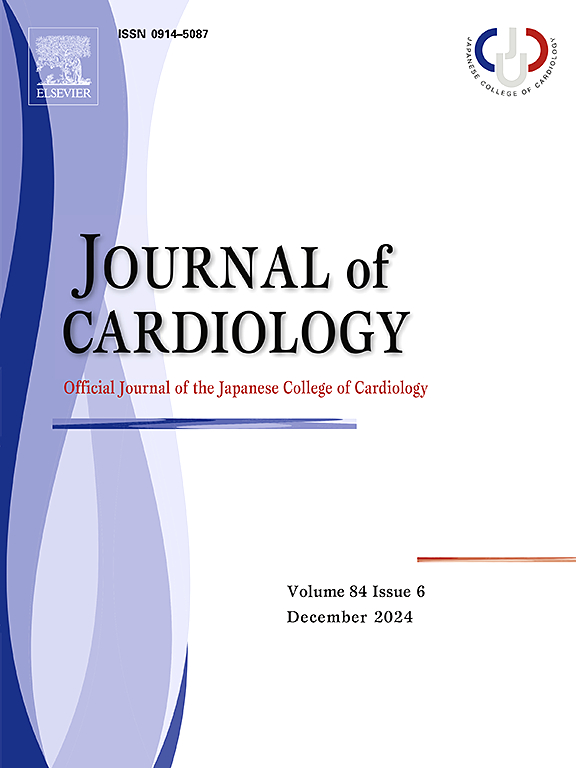Impact of right ventricular and pulmonary vascular characteristics on Impella hemodynamic support in biventricular heart failure: A simulation study
IF 2.6
3区 医学
Q2 CARDIAC & CARDIOVASCULAR SYSTEMS
引用次数: 0
Abstract
Background
Impella (Abiomed, Danvers, MA, USA) is a percutaneous ventricular assist device commonly used in cardiogenic shock, providing robust hemodynamic support, improving the systemic circulation, and relieving pulmonary congestion. Maintaining adequate left ventricular (LV) filling is essential for optimal hemodynamic support by Impella. This study aimed to investigate the impact of pulmonary vascular resistance (PVR) and right ventricular (RV) function on Impella-supported hemodynamics in severe biventricular failure using cardiovascular simulation.
Methods
We used Simulink® (Mathworks, Inc., Natick, MA, USA) for the simulation, incorporating pump performance of Impella CP determined using a mock circulatory loop. Both systemic and pulmonary circulation were modeled using a 5-element resistance–capacitance network. The four cardiac chambers were represented by time-varying elastance with unidirectional valves. In the scenario of severe LV dysfunction (LV end-systolic elastance set at a low level of 0.4 mmHg/mL), we compared the changes in right (RAP) and left atrial pressures (LAP), total systemic flow, and pressure–volume loop relationship at varying degrees of RV function, PVR, and Impella flow rate.
Results
The simulation results showed that under low PVR conditions, an increase in Impella flow rate slightly reduced RAP and LAP and increased total systemic flow, regardless of RV function. Under moderate RV dysfunction and high PVR conditions, an increase in Impella flow rate elevated RAP and excessively reduced LAP to induce LV suction, which limited the increase in total systemic flow.
Conclusions
PVR is the primary determinant of stable and effective Impella hemodynamic support in patients with severe biventricular failure.

右心室和肺血管特征对双心室心力衰竭患者 Impella 血流动力学支持的影响:模拟研究。
背景:Impella(Abiomed,丹佛斯,马萨诸塞州,美国)是一种经皮心室辅助装置,常用于心源性休克,可提供强有力的血流动力学支持,改善全身循环,缓解肺充血。保持足够的左心室(LV)充盈对 Impella 的最佳血流动力学支持至关重要。本研究旨在利用心血管模拟研究肺血管阻力(PVR)和右心室(RV)功能对严重双心室衰竭时 Impella 支持血流动力学的影响:我们使用 Simulink® (Mathworks, Inc., Natick, MA, USA)进行模拟,结合使用模拟循环环路确定的 Impella CP 泵性能。全身循环和肺循环均使用 5 元电阻电容网络建模。四个心腔由单向瓣膜的时变弹性表示。在严重左心室功能障碍的情况下(左心室收缩末期弹性设定在 0.4 mmHg/mL 的低水平),我们比较了在不同程度的 RV 功能、PVR 和 Impella 流速下右心房压力(RAP)和左心房压力(LAP)、全身总流量以及压力-容积环路关系的变化:模拟结果显示,在低 PVR 条件下,无论 RV 功能如何,Impella 流速的增加都会轻微降低 RAP 和 LAP,并增加全身总血流量。在中度 RV 功能障碍和高 PVR 条件下,Impella 流速增加会升高 RAP 并过度降低 LAP 以引起 LV 抽吸,从而限制了全身总血流量的增加:结论:PVR 是决定严重双心室衰竭患者能否获得稳定有效的 Impella 血流动力学支持的主要因素。
本文章由计算机程序翻译,如有差异,请以英文原文为准。
求助全文
约1分钟内获得全文
求助全文
来源期刊

Journal of cardiology
CARDIAC & CARDIOVASCULAR SYSTEMS-
CiteScore
4.90
自引率
8.00%
发文量
202
审稿时长
29 days
期刊介绍:
The official journal of the Japanese College of Cardiology is an international, English language, peer-reviewed journal publishing the latest findings in cardiovascular medicine. Journal of Cardiology (JC) aims to publish the highest-quality material covering original basic and clinical research on all aspects of cardiovascular disease. Topics covered include ischemic heart disease, cardiomyopathy, valvular heart disease, vascular disease, hypertension, arrhythmia, congenital heart disease, pharmacological and non-pharmacological treatment, new diagnostic techniques, and cardiovascular imaging. JC also publishes a selection of review articles, clinical trials, short communications, and important messages and letters to the editor.
 求助内容:
求助内容: 应助结果提醒方式:
应助结果提醒方式:


